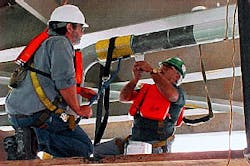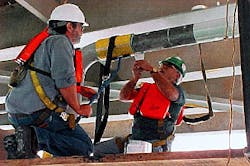Subsea/Surface Systems Technology
William Furlow
Houston
The Clock Spring system offers new options for repairing risers offshore. By avoiding the need to weld product proves versatile.
Saga adopts ultrasonic slurrification on Varg
Saga has adopted Expro Group's ultrasonic processing and slurrification of drill bit cuttings prior to reinjection on the Varg field in the Norwegian North Sea. Drill cuttings are collected after they move through the shale shakers and are transported to a mixing system where they are introduced to a specific volume of seawater.The only mud transported with the cuttings is the contamination on the cuttings themselves, which is 5-10% by weight. This slurry is pumped at 3-6 bbl/min through the Ultrasonic Processors. Inside the processor, the slurry is bombarded by sonic waves from piezoelectric crystals located on the external surface of the processor, breaking down and reducing the size of the solids in the cuttings. The sonicated slurry is then passed over a shaker with a classifying screen of 300 microns. Any course material is run through the system again. Fines are batch processed for re-injection into the wellbore.
The first Varg well where the system was applied showed size reductions in 97% of the cuttings (Jurassic and Triassic lithologies) below 300 microns, following a sonification retention time of 20 seconds. The majority of this size reduction occurred in the first few seconds of exposure to the sonic waves. The speed of size reduction allowed the operator to increase throughput, compared to the traditional grinding systems. During the drilling of the 12 1/4 in. hole section, the system successfully handled ROPs up to 80 meters/hour. The system is designed to process up to 25 metric tons of oil-wet cuttings per hour. Overall, 518 tons of oil-wet cuttings were treated and injected from the 12 1/4 in. interval at Varg.
Chevron patents injection program
Chevron USA has patented a program for calculating the optimum gas injection rate in a gas lift well. The technology allows the injection rate to vary, based on an optimal gas-lift slope. To maintain this slope, the computer regulates the injection rate of gas based on the flow of oil from the formation. The gas injection rates are adjusted incrementally to compensate for the depletion of the fluids in the well.Each of the incremental rates produces a slope between the injection and production rates, which is compared to the optimal slope. Up to three incremental changes can be made by the program to maintain optimal production from the well again based on the initially established optimal gas-lift slope. This patent number 5871048 was issued in February 1999.
Fiber coil offers riser repair option
Alvin Donatto, Senior Field Foreman with Amoco Production, said his company is having some success with a new riser repair product called the Clock Spring Composite Structural Reinforcement System. This glass fiber repair system, manufactured by Clock Spring of Houston, eliminates the shut-in of production while making repairs above the water line.Corrosion on offshore platforms is a way of life. Inspection and maintenance of pipeline risers catches most of the problems, but occasionally corrosion is not observed on risers, either through inaccessibility or because the corrosion occurs in hidden areas such as riser clamps.
In the past, the only methods of repairing a corroded or mechanically damaged pipe were to shut in and replace the pipe, weld on a split sleeve, or bolt clamp the area. The riser can be repaired with a split sleeve during flow, because the flow of gas or liquid draws heat down the line, preventing the riser from bursting under the heat of the weld.
When problems occur near the platform's processing equipment, government regulations and safe operating practices require that production be shut in prior to welding near process equipment. Not only does this interrupt production, but it makes the repair more difficult because the riser does not have flowing production, which dissipates the heat created during a split sleeve well repair.
The Clock Spring sleeve is a coil of high-strength unidirectional glass fibers impregnated with a corrosion resistant polyester resin system that comes in a roll 12 in. wide and sized for the specific pipe. Intimate contact between the Clock Spring and pipe is achieved during installation by combining the "memory" matrix of the Clock Spring with the proprietary load transferring agent and adhesive system.
Installation of the coil requires cleaning the pipe by blasting with any method providing an anchor pattern.
A load transferring agent is applied to fill voids or gaps left after cleaning. The damaged section of pipe and coil are coated with an adhesive and the coil is attached. A special tool is used to tighten the repair and the coil is held in place while the adhesive cures. Once the adhesive is cured, the repair is ready for painting. The whole process requires three hours. As long as the repair is protected from the elements it should last the life of the platform or 50 years. Amoco first applied this new product to risers on the Eugene Island 224A platform in the Gulf of Mexico.
Donatto said the Clock Spring is not a replacement, but an addition to traditional repair options. The split sleeve will still be the repair of choice for most corrosion damage. But in areas near processing equipment, or on extended curved sections (with a minimum of a 5-D bend radius) or near the water line, where welding a split sleeve isn't practical, the Clock Spring offers another approach.
Air replaces fluid for drilling horizontal section
Horizontal Ventures says it has successfully completed drilling the curved section of a horizontal borehole using compressed air as the drilling fluid. This first of its kind was achieved in a West Texas dolomite reservoir. This gas well was recompleted at 3,500 ft and laterally extended 1,400 ft. The well tested at about 800 Mcf/d with a bottom hole pressure of 400 psi.Generally, liquid muds are used for drilling the curved sections of these wells, but compressed air offers advantages in areas where the muds can cause near-hole damage. Horizontal Ventures focuses its efforts on declining fields and uses BP Amoco's short-radius horizontal drilling technology to boost production rates from these fields.
Copyright 1999 Oil & Gas Journal. All Rights Reserved.

